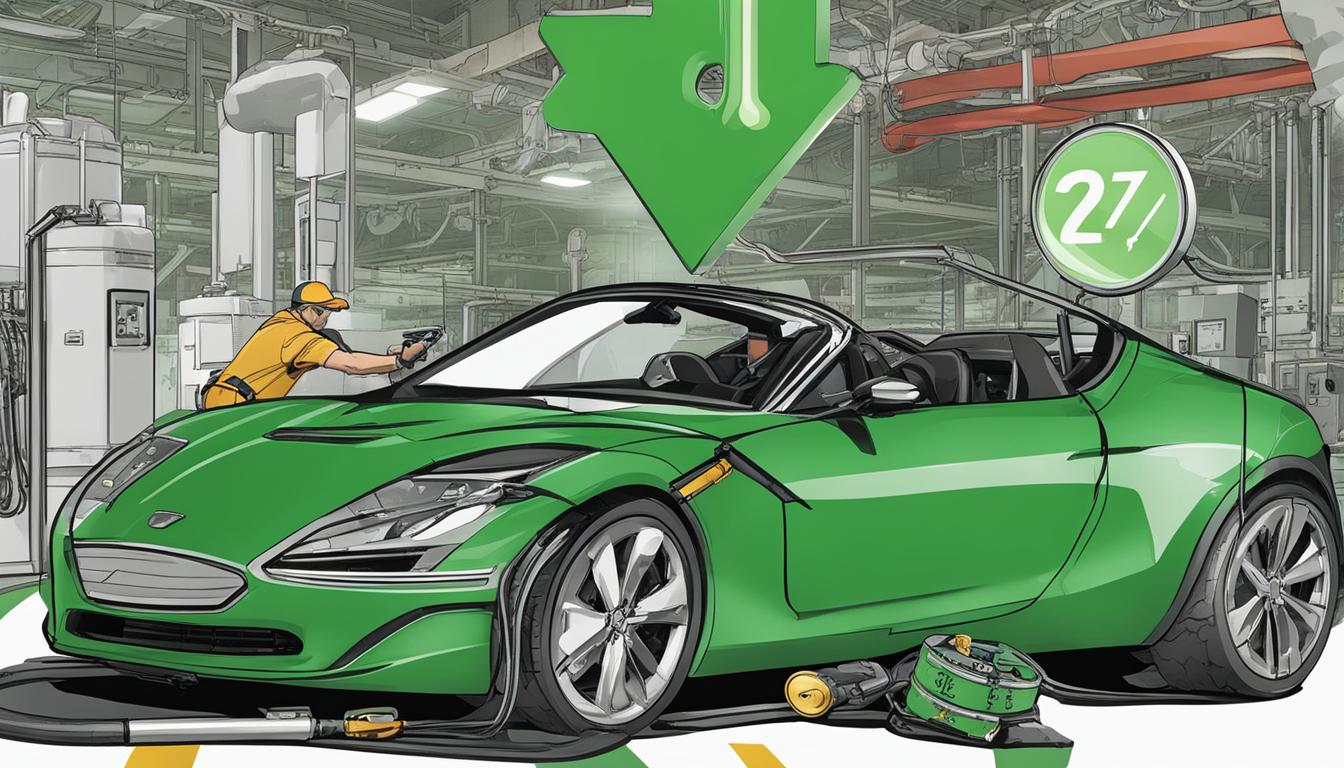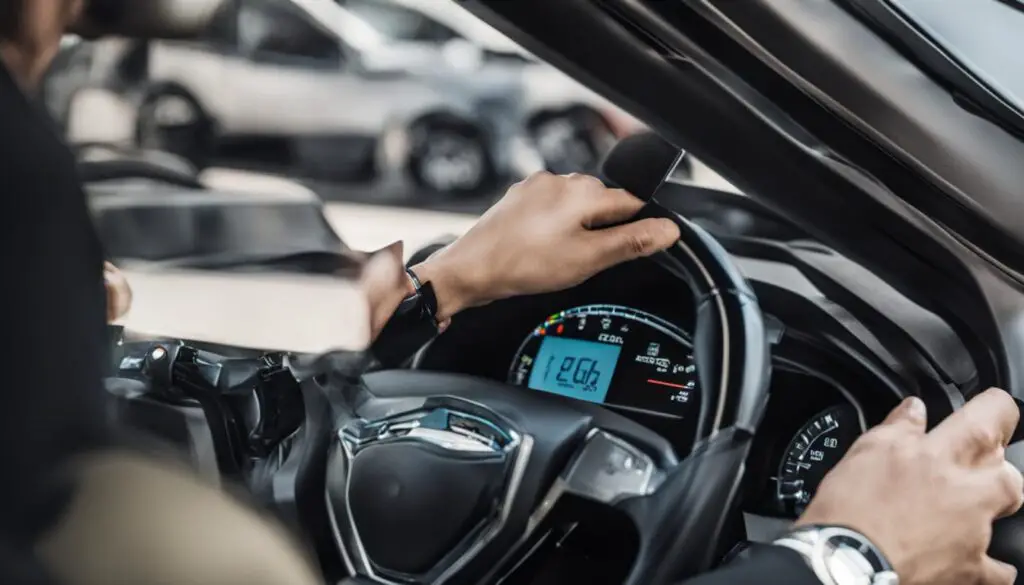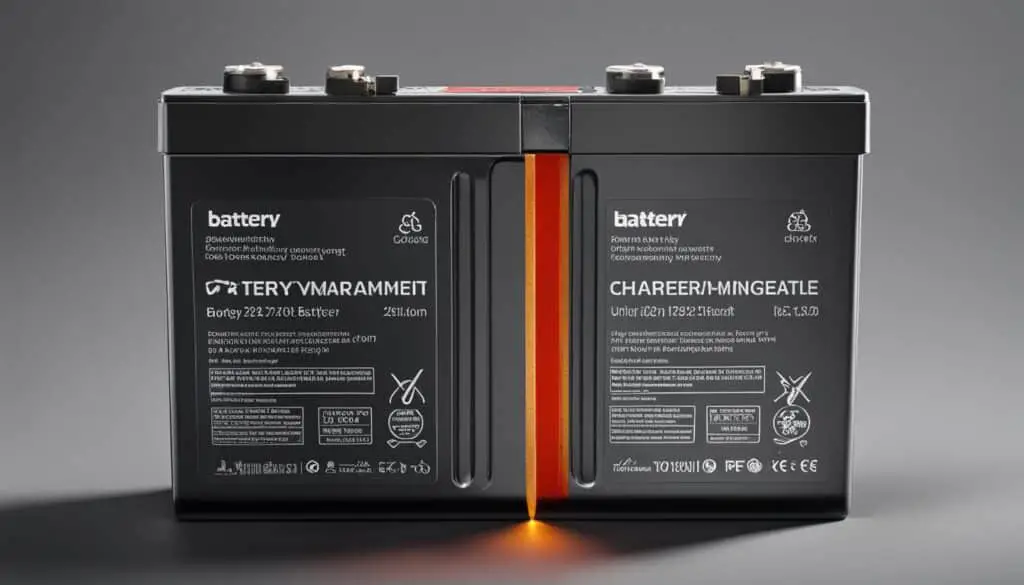
Understanding EV Battery Health: Maintenance and Monitoring Tips
As electric vehicles continue to gain popularity for their lower emissions and environmental benefits, it is essential to understand how to maintain and monitor the health of their batteries. By following these maintenance and monitoring tips, you can extend the lifespan of your electric vehicle battery, maximize its performance, and save on replacement costs.
Key Takeaways:
- Regularly monitor and maintain your electric vehicle battery to optimize its performance and lifespan.
- Understand the basics of EV batteries, such as their chemistry and charging cycles, to make informed decisions for battery health.
- Optimize your driving habits to conserve energy and make use of features like regenerative braking for improved battery efficiency.
- Manage battery temperature within recommended ranges to avoid performance degradation, especially in extreme temperatures.
- Follow best practices for charging, such as timing your charges, using consistent patterns, and being mindful of energy consumption.
Understand Battery Basics and Charging Cycles
Before optimizing battery health, it is important to understand some battery basics. Electric vehicle (EV) batteries are typically lithium-ion, known for their high energy density and long lifespan. Factors such as battery chemistry and charging cycles play a crucial role in determining battery life and performance.
EV Battery Lifespan:
- Lithium-ion batteries used in EVs have an average lifespan of 8-15 years, depending on usage and maintenance.
- Regular maintenance and following recommended charging practices can extend the battery’s lifespan.
- Frequent fast charging and deep discharging can degrade the battery faster.
Battery Capacity:
- The capacity of an EV battery determines the range and performance of the vehicle.
- The capacity is measured in kilowatt-hours (kWh) and varies depending on the EV model.
- Higher battery capacity allows for longer driving ranges and better overall performance.
Charging Cycles:
- A charging cycle refers to the process of charging and discharging a battery once.
- Each complete charging cycle contributes to the gradual degradation of the battery’s capacity.
- Partial charging cycles, such as charging from 20% to 80% multiple times, can help preserve battery life.
Battery Chemistry:
- Lithium-ion batteries use different chemistries that impact their performance and longevity.
- The most common lithium-ion chemistries are NMC (Nickel Manganese Cobalt) and NCA (Nickel Cobalt Aluminum).
- Each chemistry has its own trade-offs in terms of energy density, lifespan, and cost.
To visually illustrate the impact of charging cycles on EV battery capacity, refer to the following table:
| Charging Cycles | Average Battery Capacity Retained |
|---|---|
| 0-100 cycles | 100% |
| 100-200 cycles | 95-98% |
| 200-300 cycles | 90-95% |
| 300-400 cycles | 85-90% |
| 400-500 cycles | 80-85% |
In conclusion, understanding EV battery basics, including battery lifespan, capacity, charging cycles, and chemistry, is crucial for optimizing battery health and performance. By implementing proper charging practices and considering factors that impact battery degradation, EV owners can maximize their battery’s lifespan and overall efficiency.
Optimizing Driving Habits for Battery Efficiency
When it comes to maximizing battery efficiency, your driving habits play a crucial role. By implementing some simple strategies, you can conserve energy, utilize regenerative braking, and plan your range effectively. Based on factual data, here are some tips to optimize your driving habits for the best battery performance:
1. Smooth Acceleration and Deceleration
Smooth and gradual acceleration and deceleration help conserve energy and reduce strain on the battery. Avoid aggressive acceleration, harsh braking, and sudden speed changes, as these actions can drain the battery quickly. Maintaining a steady driving pace will yield better energy conservation.
2. Utilize Regenerative Braking
One of the advantages of electric vehicles is regenerative braking, which converts kinetic energy into electrical energy and stores it back in the battery. Take advantage of this feature by reducing your reliance on traditional braking methods. When you anticipate the need to slow down or stop, ease off the accelerator pedal gradually to engage regenerative braking, which helps recharge the battery.
“Regenerative braking not only helps extend your battery range, but it also reduces wear on your brake pads.”
3. Plan your Range
Before embarking on a journey, it’s essential to plan your range and factor in charging stops along the way if necessary. Utilize mobile apps or in-car navigation systems to locate charging stations and optimize your route accordingly. Planning ahead ensures you have a clear idea of the distance you can cover, reduces range anxiety, and minimizes the risk of running out of charge.
4. Reduce Unnecessary Power Consumption
To conserve battery power, it’s essential to reduce unnecessary energy consumption. Turn off unnecessary electrical components such as heated seats, air conditioning, and defrosters when they’re not in use. Additionally, avoid excessive idling as it drains the battery without providing any mileage. By minimizing power consumption, you’ll optimize your battery efficiency.
5. Maintain a Steady Pace on Highways
On highways, maintaining a steady pace is crucial for energy conservation. Higher speeds lead to increased wind resistance, which requires more energy to overcome. Try to drive at a consistent speed to minimize energy expenditure and maximize battery efficiency.
By implementing these driving habit optimizations, you can significantly enhance your electric vehicle’s battery efficiency and range. Keep in mind that each vehicle and driving situation may vary, so it’s important to consult your vehicle’s manual for specific driving recommendations.

Temperature Management for Extended Battery Life
Managing battery temperature is crucial for optimal performance. To ensure your electric vehicle (EV) battery lasts longer and operates efficiently, it’s essential to follow proper temperature management strategies. Here are some facts and precautions:
Battery Temperature: Maintaining the right temperature range is vital for battery health. Extreme heat or cold can negatively impact the battery’s performance and longevity.
Heat Management: Excessive heat can accelerate battery degradation. Avoid exposing your EV to direct sunlight for prolonged periods, particularly during hot weather conditions. Parking under shade or using car window shades can help minimize heat buildup.
Cold Weather Precautions: Cold temperatures can reduce battery efficiency and range. Here are some tips to consider in colder climates:
- Preconditioning: Using your EV’s climate control system while connected to a charger can help warm up the battery before driving. This can enhance performance and preserve range.
- Garage or Shelter: Parking your EV in a garage or sheltered area can help protect it from extreme cold and minimize temperature fluctuations.
- Plug-In Priorities: Plugging in your EV during cold weather ensures the battery remains warmer, preserving its charge and overall performance.
- Charge Timing: Consider scheduling your charging sessions during milder parts of the day to prevent exposing the battery to excessively low temperatures.
- Regenerative Braking: Utilize regenerative braking whenever possible, as it helps generate heat within the battery, keeping it warmer during cold weather.
By practicing these temperature management strategies, you can prolong the lifespan of your EV battery and optimize its performance.

| Temperature Range | Effect on Battery Performance |
|---|---|
| Optimal Range (20°C to 25°C) | Battery operates at maximum efficiency and delivers peak performance. |
| High Temperatures (>40°C) | Accelerated battery degradation, reduced capacity, and shortened lifespan. |
| Low Temperatures (<0°C) | Reduced range, slower charging speeds, and decreased overall battery efficiency. |
Best Practices for Charging to Prolong Battery Life
Proper charging practices are essential for maximizing the lifespan of your electric vehicle battery. By following these tips based on factual data, you can ensure optimal battery health and performance:
1. Charging Timing and Energy Consumption
Timing your charging sessions can have a significant impact on overall battery health. It is advisable to charge your electric vehicle when the battery level falls between 20-80%. Avoid letting the battery charge drop below 20% or reach a full 100% charge frequently.
Consistent charging within this range helps minimize stress on the battery cells and reduces the chances of overcharging or deep discharging. By adopting this charging pattern, you’ll optimize energy consumption and prolong battery life.
2. Consistent Charging Patterns
Establishing a consistent charging routine is crucial for battery longevity. Aim for a consistent charging pattern that suits your daily driving needs. If possible, plug in your electric vehicle every night to maintain a stable charge level.
Consistency in charging patterns helps the battery operate in an optimal temperature range, reducing wear and maintaining overall health. Additionally, it ensures that you have sufficient range on a daily basis.
3. Choose the Right Charger Type
There are different types of chargers available, including Level 1, Level 2, and DC Fast Chargers. Using the right charger type for your electric vehicle can influence battery performance and charging speed.
Level 1 chargers are suitable for overnight charging at home, while Level 2 chargers offer faster charging times. DC Fast Chargers provide rapid charging for on-the-go convenience, but frequent use may impact long-term battery health due to higher charging rates.
Refer to your electric vehicle manufacturer’s recommendations to select the appropriate charger type that balances your charging needs and battery health.
| Charger Type | Charging Speed | Battery Health Impact |
|---|---|---|
| Level 1 | Slow | Minimal impact |
| Level 2 | Medium | Negligible impact |
| DC Fast Charger | Fast | Potential impact with frequent use |
4. Take Advantage of Smart Charging Features
Modern electric vehicles often come with smart charging features that enable you to schedule charging sessions and take advantage of off-peak electricity rates. Utilizing these features helps optimize energy consumption and reduce charging costs.
By setting your electric vehicle to charge during non-peak hours, you not only save money but also minimize strain on the electrical grid. This smart approach contributes to better battery health and overall sustainability.
Implementing these best practices for charging your electric vehicle based on factual data will help extend the lifespan of your battery, maximize performance, and ensure a smooth driving experience.
Software Updates and Maintenance
Regular software updates and maintenance checks are essential for maximizing the lifespan and performance of your electric vehicle (EV) battery. By keeping your software up to date and conducting regular maintenance checks, you can identify and address any issues before they escalate, ensuring the optimal functioning of your battery.
Software updates provide important bug fixes, security enhancements, and performance improvements for your EV’s battery management system. These updates are designed to optimize battery efficiency, enhance charging capabilities, and address any software-related issues that may affect battery performance.
Additionally, maintenance checks allow technicians to inspect the overall health of your battery system and identify any potential problems. Through comprehensive diagnostic tests and evaluations, they can assess battery performance, detect any abnormalities or degradation, and take appropriate actions to maintain the battery’s longevity.
The Importance of Battery Diagnostics
Battery diagnostics play a crucial role in ensuring the long-term health of your EV battery. By utilizing advanced diagnostic tools and techniques, technicians can gather accurate data about your battery’s state of health, state of charge, and overall condition.
With the help of battery diagnostics, technicians can:
- Monitor battery cell voltages and temperature
- Detect abnormalities in charging and discharging patterns
- Identify and rectify potential software or hardware issues
- Assess the overall performance and efficiency of the battery
By regularly performing battery diagnostics, you can stay proactive in managing and maintaining your battery’s health, ensuring optimal performance and maximizing its lifespan.
| Benefits of Software Updates and Maintenance | |
|---|---|
| 1. Improved Battery Efficiency | Regular updates optimize battery performance and efficiency, maximizing range and reducing energy consumption. |
| 2. Enhanced Charging Capabilities | Software updates address charging-related issues, allowing for faster and more reliable charging. |
| 3. Early Issue Detection | Maintenance checks help identify and resolve any potential problems before they escalate, minimizing the risk of battery failure. |
| 4. Prolonged Battery Lifespan | By staying proactive in maintenance and software updates, you can extend the overall lifespan of your EV battery. |
Ensuring Battery Health Over Time
Consistently monitoring battery health is crucial for prolonging battery life. By following these practical steps, based on factual data, you can maximize the lifespan of your electric vehicle’s battery:
1. Monitor Battery Health Regularly
Keep track of your battery’s condition through battery health monitoring systems or apps. These tools provide valuable insights into the state of your battery, including its capacity and charging cycles. By monitoring battery health, you can detect any abnormalities early on and take appropriate actions.
2. Optimize Charging Cycles
Charge your battery to the appropriate level based on your daily driving needs. Avoid regular deep discharges and excessive charging. Optimal charging cycles can help maintain battery capacity and prolong its overall lifespan.
3. Practice Controlled Charging
Avoid exposing your electric vehicle to extreme temperatures during charging. High temperatures can accelerate battery degradation, while extremely low temperatures can affect charging efficiency. Whenever possible, charge your vehicle in a temperature-controlled environment.
4. Implement Smart Range Planning
Plan your trips carefully, taking into account your battery’s range. By planning efficient routes and reducing unnecessary stops, you can minimize energy consumption and reduce strain on the battery.
5. Follow Manufacturer Guidelines
Refer to your electric vehicle’s user manual for specific recommendations from the manufacturer regarding battery maintenance and charging practices. Following these guidelines can help optimize battery performance and extend its lifespan.
6. Consider Battery Replacement When Necessary
If your battery’s health deteriorates significantly over time, it may be necessary to consider battery replacement. Consult with an authorized service center or the vehicle manufacturer to determine the best course of action for your specific situation.
Remember, proactive monitoring and maintenance are key to ensuring a healthy battery and maximizing your electric vehicle’s performance.
| Benefits | Best Practices | |
|---|---|---|
| Battery Health Monitoring | Allows early detection of battery issues |
|
| Charging Cycles | Affects battery lifespan |
|
| Battery Replacement | Ensures optimal performance |
|
Conclusion
Taking proper care of your EV’s battery is essential for optimizing its performance and extending its lifespan. By implementing the battery maintenance tips and strategies outlined in this article, you can ensure that you get the most out of your electric vehicle.
From understanding battery basics and charging cycles to optimizing your driving habits and managing temperature, there are various factors to consider for maximizing battery efficiency. Charging your EV consistently and following best practices, such as avoiding deep discharges and choosing the right charger type, can significantly impact the overall health of your battery.
Regular software updates and maintenance checks are equally important in maintaining the health of your EV battery. By keeping your software up to date and performing regular diagnostics, you can identify any potential issues early on and take appropriate measures to prevent any further damage to the battery.
Lastly, consistently monitoring your battery health and being mindful of the number of charging cycles can help you determine when it might be time for a battery replacement. By following these battery maintenance tips and optimizing battery performance, you can enjoy a longer EV battery lifespan and a more efficient and reliable electric vehicle.
FAQ
What type of battery do electric vehicles use?
Electric vehicles typically use lithium-ion batteries, known for their high energy density and long lifespan.
How does driving habits affect battery efficiency?
Driving habits play a significant role in maximizing battery efficiency. By practicing energy conservation techniques such as regenerative braking and efficient range planning, you can optimize the performance of your EV battery.
How can I manage battery temperature for optimal performance?
Proper temperature management is crucial for extended battery life. It is advised to avoid extreme heat or cold weather conditions and park your vehicle in shaded areas when possible. Additionally, using battery thermal management systems and pre-conditioning the battery before driving can help maintain optimal temperature.
What are the best practices for charging an electric vehicle?
To prolong battery life, it is recommended to charge your EV using consistent charging patterns. Avoid frequent fast charging and maintain a moderate charging rate. It is also important to consider charging timing to take advantage of lower electricity rates during off-peak hours.
Do software updates and maintenance checks contribute to battery longevity?
Yes, regular software updates and maintenance checks are crucial for prolonging battery life. These updates ensure the optimal performance of your EV’s battery and can also include battery diagnostics to detect any potential issues.
How can I monitor the health of my EV battery?
Consistently monitoring your EV battery health is vital. This can be done through the vehicle’s onboard systems, which provide information on battery capacity, charging cycles, and overall health. It is also recommended to follow manufacturer guidelines for battery health monitoring and consider professional battery diagnostic services if needed.
Why is it important to take care of the EV battery?
Taking proper care of your EV battery is essential for maximizing its performance and longevity. By following battery maintenance tips and implementing strategies to optimize battery health, you can ensure a longer lifespan for your electric vehicle battery.
